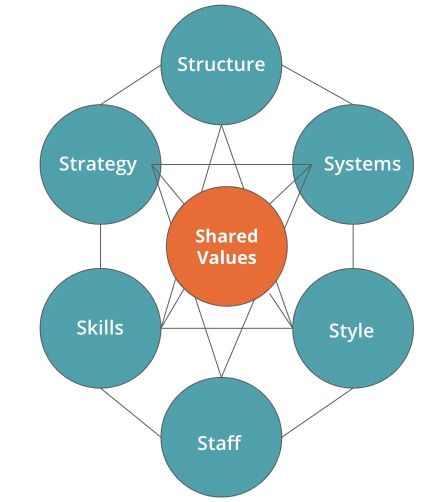The McKinsey 7S Framework:
Enterprises can leverage the McKinsey 7S Framework to effectively navigate their digital transformation journey. Here’s an approach on how each element of the framework can be aligned with digital transformation efforts.
The McKinsey 7S Framework is a powerful tool for understanding and analyzing organizations. Developed by McKinsey & Company consultants in the 1980s, it emphasizes the interconnectedness of seven key elements that drive organizational effectiveness:
- Strategy: The plan devised to achieve organizational goals.
- Structure: The formal organization of departments, jobs, and reporting relationships.
- Systems: The processes and procedures that govern daily operations.
- Shared Values: The core beliefs and assumptions that guide employee behaviour.
- Style: The leadership style and overall organizational culture.
- Staff: The skills, experience, and competencies of employees.
- Skills: The distinctive capabilities and competencies of the organization.
The Interconnectedness of the 7S
The 7S Framework recognizes that these elements are not independent but rather intertwined and mutually reinforcing. Changes in one area will inevitably impact the others. For example, a new strategy may require changes to the organizational structure, systems, and employee skills.
How to Use the 7S Framework
Being a digital lead the first step is to start from begin by assessing the current state of your organization for each of the seven elements. This can be done through surveys, historical project, exiting digital capabilities by interviews, and observations. Once some data available and purpose of transformation is identified start analyzing the data collected to identify strengths, weaknesses, and areas for improvement. Determine how well the seven elements are aligned with each other and with the organization’s overall strategy. Develop a plan to address any misalignments or gaps identified in the analysis phase. This may involve changes to strategy, structure, systems, or other elements. Implement the changes outlined in the development plan. This may involve training, restructuring, or process improvement initiatives. Continuously monitor and evaluate the effectiveness of the changes implemented. Make adjustments as needed to ensure ongoing alignment and organizational effectiveness.
- Strategy: – Define a Clear Digital Vision: Develop a comprehensive digital strategy that outlines the organization’s long-term goals and objectives. What are existing digital capabilities and organisation instrument purpose for going digital. This should include a roadmap for implementing new technologies, enhancing digital capabilities, and achieving competitive advantages. Example: A retail company might aim to enhance customer experience through e-commerce platforms, mobile apps, and personalized marketing.
- Structure:-Adapt Organizational Structure: Restructure the organization to support digital initiatives. This might involve creating new departments or new leadership teams focused on digital innovation, data analytics, and IT. Example: A financial services firm could establish a dedicated digital transformation office to oversee and coordinate all digital projects and initiatives.
- Systems:-Implement Robust IT Systems: Upgrade existing IT systems and infrastructure to support digital transformation. This includes adopting cloud computing, AI, machine learning, and automation technologies. Example: A manufacturing company might implement IoT devices and data analytics platforms to optimize production processes and improve efficiency.
- Shared Values:-Foster a Digital Culture: Promote a culture that embraces digital innovation and change. Encourage collaboration, continuous learning, and a growth mind-set among employees. Example: A healthcare organization could emphasize the importance of digital health technologies in improving patient care and outcomes.
- Skills Enhance Digital Skills: Invest in training and development programs to equip employees with the necessary digital skills. This includes upskilling in areas such as data analysis, cybersecurity, and digital marketing. Example: A logistics company might provide training on advanced analytics and supply chain management technologies to its workforce.
- Style:-Adopt Agile Leadership Styles: Encourage leadership styles that promote agility, innovation, and adaptability. Leaders should inspire and motivate employees to embrace digital transformation. Example: A technology company could implement agile methodologies and practices to enhance collaboration and speed up project delivery.
- Staff:-Align Talent Management with Digital Goals: Recruit and retain talent with the necessary digital expertise. Ensure that HR policies and practices support the organization’s digital transformation objectives. Example: An educational institution might hire data scientists, digital content creators, and IT specialists to support its online learning initiatives.
Case Study: Adobe’s Digital Transformation
Adobe, traditionally known for its creative software products, embarked on a digital transformation journey to shift from a product-based business model to a subscription-based model with a strong focus on cloud services.
- Strategy: Adobe redefined its strategy to focus on cloud-based subscription services, emphasizing continuous updates and customer engagement.
- Structure: The company restructured its organization to support the new subscription model, creating dedicated teams for cloud services and customer success.
- Systems: Adobe invested in robust IT systems to support its cloud infrastructure and ensure seamless delivery of services to customers.
- Shared Values: The company fostered a culture of innovation and customer-centricity, emphasizing the importance of delivering value through continuous improvements and customer feedback.
- Skills: Adobe enhanced its workforce’s skills through training programs on cloud technologies, data analytics, and customer relationship management.
- Style: Leadership adopted an agile approach, promoting collaboration and rapid iteration to respond quickly to market demands and customer needs.
- Staff: Adobe aligned its talent management practices with its digital goals, recruiting and retaining experts in cloud computing, data science, and digital marketing.
Outcome: Adobe’s successful digital transformation resulted in a significant increase in revenue, higher customer satisfaction, and a stronger competitive position in the market.
Benefits of Using the 7S Framework
- Improved Organizational Alignment: By identifying and addressing misalignments between the seven elements, organizations can improve their overall effectiveness and efficiency.
- Enhanced Decision-Making: The framework provides a holistic view of the organization, enabling better-informed decisions about strategic direction, organizational change, and resource allocation.
- Increased Employee Engagement: By understanding and addressing the values, culture, and skills of employees, organizations can improve employee engagement and motivation.
- Enhanced Organizational Flexibility: The framework helps organizations adapt to changing market conditions and other external pressures. #McKinsey7SFramework ; #DigitalTransformation ; #BusinessStrategy ; #Leadership ; #DigitalCulture;



